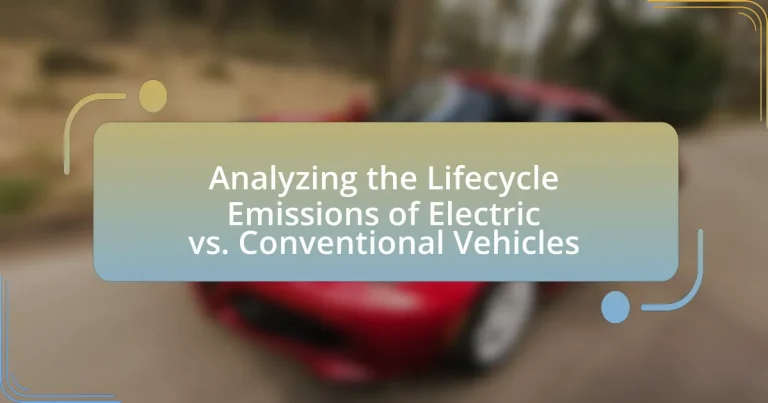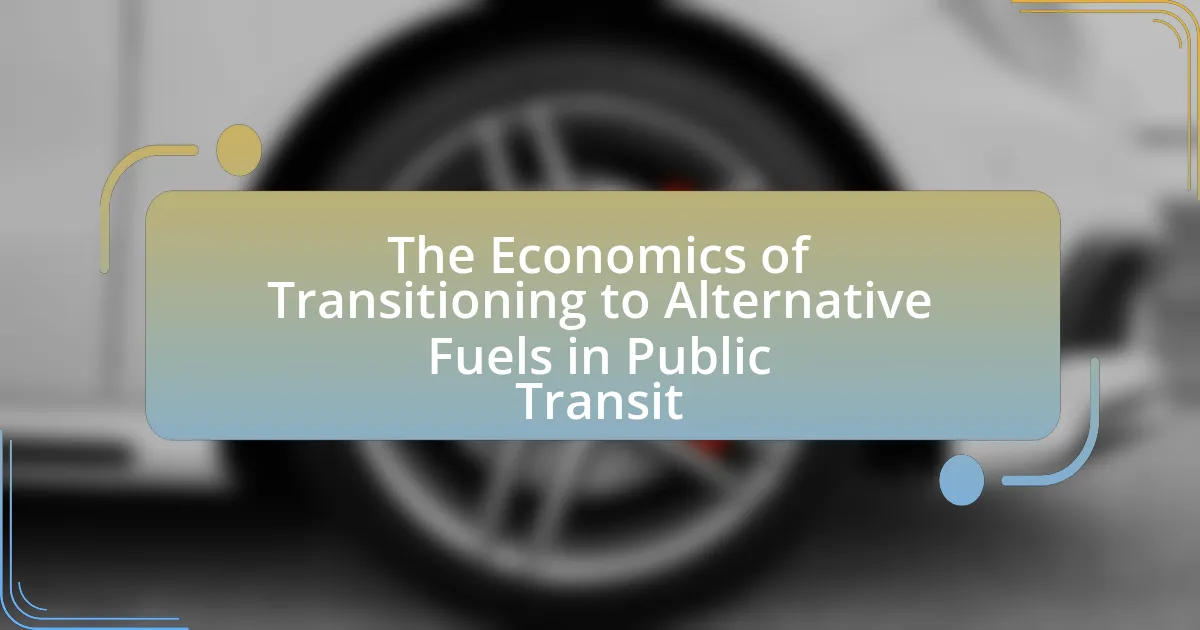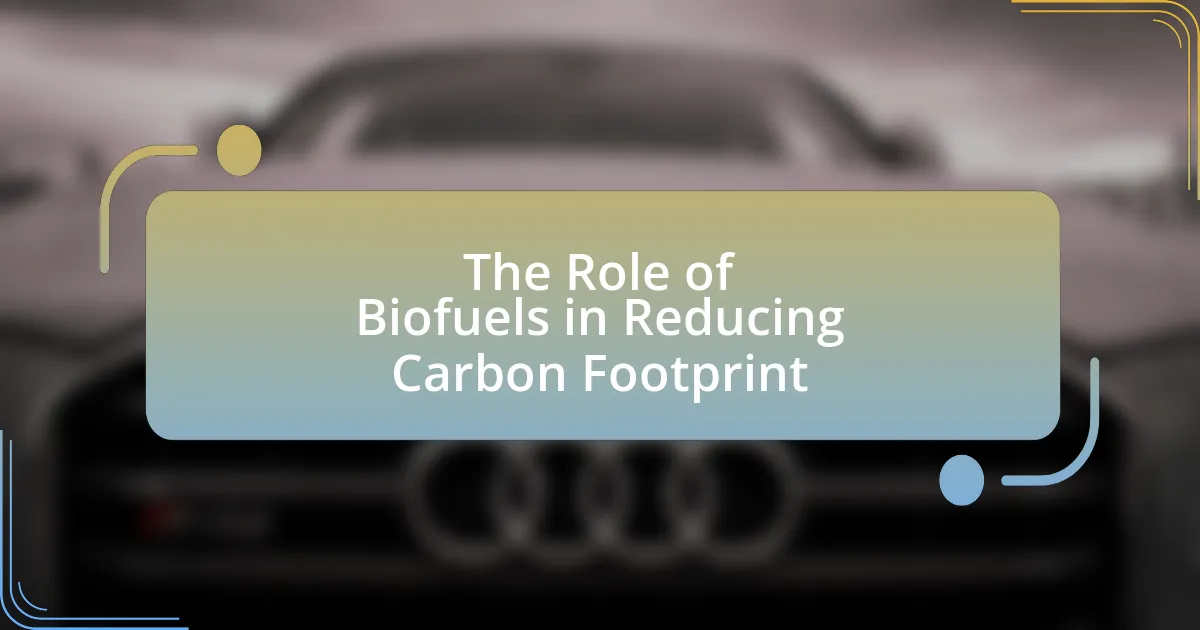The article focuses on analyzing the lifecycle emissions of electric vehicles (EVs) compared to conventional gasoline vehicles. It defines lifecycle emissions as the total greenhouse gas emissions produced from a vehicle’s production to its disposal, highlighting the importance of assessing emissions at each stage, including manufacturing, operation, and end-of-life. Key findings indicate that while EVs may have higher emissions during production due to battery manufacturing, they generally produce significantly lower operational emissions, resulting in an overall reduction in lifecycle emissions. The article also discusses the implications of lifecycle emissions analysis for policymakers and consumers, emphasizing the role of incentives and regulations in promoting sustainable transportation choices.
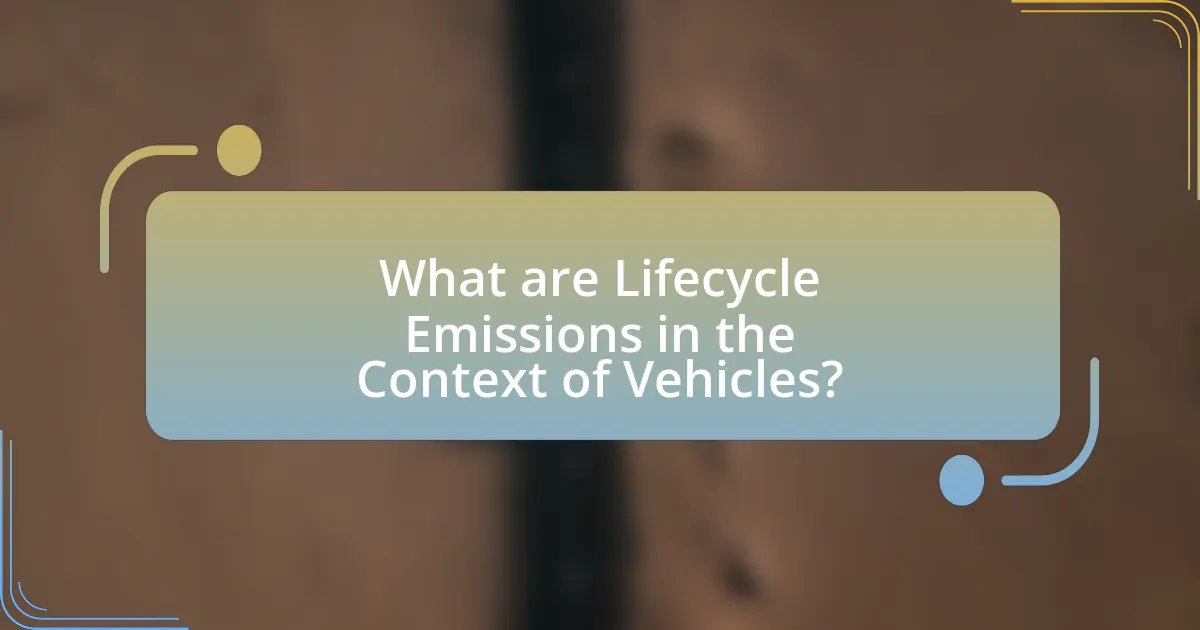
What are Lifecycle Emissions in the Context of Vehicles?
Lifecycle emissions in the context of vehicles refer to the total greenhouse gas emissions produced throughout a vehicle’s entire lifespan, from production to disposal. This includes emissions generated during the manufacturing of the vehicle, the fuel or electricity consumed during its operation, and the emissions associated with the end-of-life disposal or recycling processes. For example, a study by the Union of Concerned Scientists indicates that electric vehicles can have lower lifecycle emissions compared to conventional gasoline vehicles, primarily due to the emissions associated with fuel extraction and combustion in traditional vehicles.
How are lifecycle emissions defined and measured?
Lifecycle emissions are defined as the total greenhouse gas emissions produced throughout the entire lifecycle of a product, from raw material extraction to manufacturing, use, and disposal. These emissions are measured using a method called Life Cycle Assessment (LCA), which quantifies environmental impacts by analyzing each stage of a product’s life. LCA involves collecting data on energy consumption, material usage, and emissions at each phase, allowing for a comprehensive evaluation of the product’s overall environmental footprint. This methodology is supported by standards such as ISO 14040 and ISO 14044, which provide guidelines for conducting LCAs and ensure consistency and reliability in the measurement of lifecycle emissions.
What stages are included in the lifecycle of a vehicle?
The lifecycle of a vehicle includes several key stages: raw material extraction, manufacturing, distribution, use, and end-of-life disposal or recycling. Each stage contributes to the overall environmental impact of the vehicle. For instance, raw material extraction involves mining for metals and minerals, which can lead to habitat destruction and pollution. Manufacturing encompasses the production of vehicle components and assembly, often resulting in significant energy consumption and emissions. Distribution refers to the transportation of vehicles to dealerships, which also contributes to carbon emissions. The use phase is where vehicles consume fuel or electricity, directly impacting emissions based on energy sources. Finally, the end-of-life stage involves dismantling, recycling, or landfilling, which can mitigate or exacerbate environmental effects depending on the processes employed.
How do emissions vary across different lifecycle stages?
Emissions vary significantly across different lifecycle stages of vehicles, including production, operation, and end-of-life. For electric vehicles (EVs), the production stage typically generates higher emissions due to battery manufacturing, which can account for up to 50% of total lifecycle emissions. In contrast, conventional vehicles have lower production emissions but higher operational emissions due to fossil fuel combustion, often resulting in greater total emissions over their lifespan. Studies indicate that while EVs may have higher initial emissions, their operational emissions are substantially lower, leading to overall lower lifecycle emissions compared to conventional vehicles. For instance, a study by the Union of Concerned Scientists found that EVs produce less than half the emissions of comparable gasoline-powered vehicles over their entire lifecycle, highlighting the importance of considering all stages when analyzing emissions.
Why is it important to analyze lifecycle emissions?
Analyzing lifecycle emissions is important because it provides a comprehensive understanding of the total environmental impact of a product, from production to disposal. This analysis helps identify the stages where emissions can be reduced, guiding policymakers and manufacturers in making informed decisions to minimize carbon footprints. For instance, a study by the Union of Concerned Scientists found that electric vehicles can produce significantly lower emissions over their entire lifecycle compared to conventional vehicles, highlighting the importance of considering all phases of a vehicle’s life when assessing environmental effects.
What impact do vehicle emissions have on the environment?
Vehicle emissions significantly contribute to environmental pollution, primarily through the release of greenhouse gases and harmful pollutants. These emissions, including carbon dioxide, nitrogen oxides, and particulate matter, lead to climate change, respiratory issues, and ecosystem degradation. For instance, the U.S. Environmental Protection Agency reported that transportation accounts for approximately 29% of total greenhouse gas emissions in the United States, highlighting the substantial impact of vehicle emissions on global warming and air quality.
How do lifecycle emissions influence consumer choices?
Lifecycle emissions significantly influence consumer choices by affecting perceptions of environmental impact and sustainability. Consumers increasingly consider the total emissions produced throughout a vehicle’s lifecycle, including manufacturing, operation, and disposal, when making purchasing decisions. Research indicates that 70% of consumers are willing to pay more for products with lower lifecycle emissions, reflecting a growing awareness of climate change and its implications. This trend is particularly evident in the automotive sector, where electric vehicles are often favored due to their lower operational emissions compared to conventional vehicles. Studies show that electric vehicles can reduce lifecycle emissions by up to 50% compared to gasoline-powered cars, further driving consumer preference towards greener alternatives.
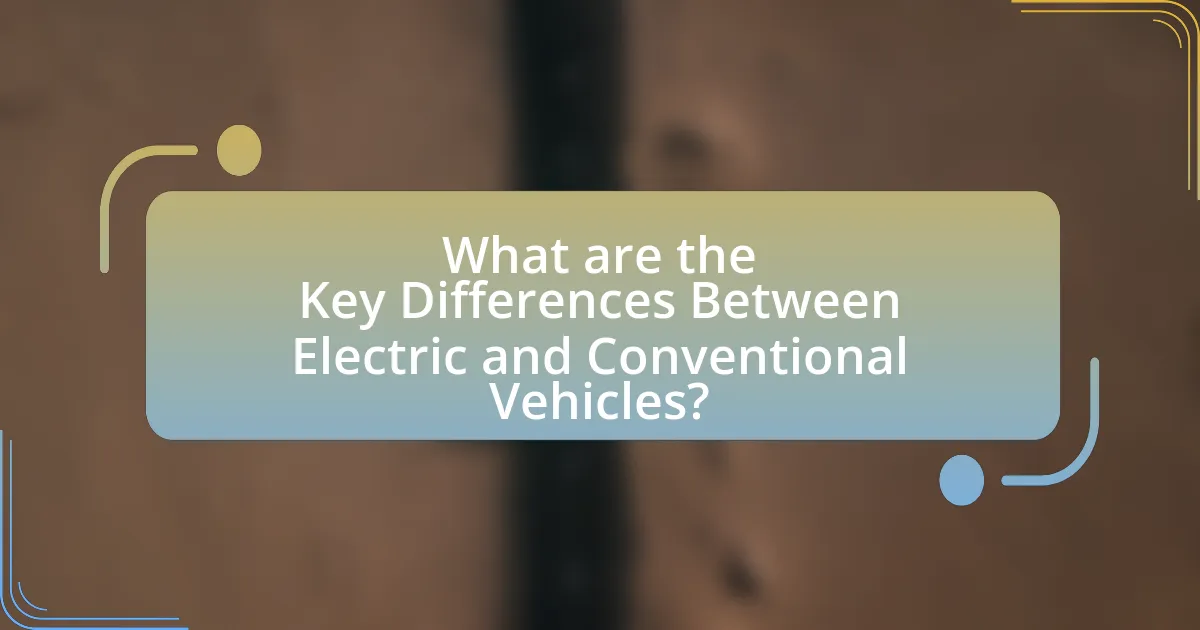
What are the Key Differences Between Electric and Conventional Vehicles?
Electric vehicles (EVs) differ from conventional vehicles primarily in their power source and emissions profile. EVs are powered by electric motors and batteries, resulting in zero tailpipe emissions during operation, while conventional vehicles rely on internal combustion engines that burn fossil fuels, producing greenhouse gases and pollutants. According to the U.S. Environmental Protection Agency, conventional vehicles emit an average of 404 grams of CO2 per mile, whereas EVs can significantly reduce lifecycle emissions, especially when charged using renewable energy sources. This fundamental difference in energy source and emissions contributes to the growing preference for electric vehicles as a more sustainable transportation option.
How do the emissions profiles of electric vehicles compare to conventional vehicles?
Electric vehicles (EVs) generally have lower emissions profiles compared to conventional vehicles, particularly when considering their entire lifecycle. While conventional vehicles emit greenhouse gases and pollutants directly from their tailpipes due to fossil fuel combustion, EVs produce no tailpipe emissions. However, the overall emissions from EVs depend on the source of the electricity used for charging. For instance, if the electricity comes from renewable sources, the emissions are significantly reduced. According to a study by the Union of Concerned Scientists, EVs produce, on average, less than half the emissions of comparable gasoline-powered vehicles over their lifetime, even when accounting for emissions from electricity generation. This demonstrates that EVs are more environmentally friendly in terms of emissions compared to conventional vehicles.
What are the emissions during the manufacturing phase for both types of vehicles?
During the manufacturing phase, electric vehicles (EVs) typically produce higher emissions compared to conventional internal combustion engine (ICE) vehicles, primarily due to the energy-intensive processes involved in battery production. Research indicates that manufacturing an electric vehicle can generate approximately 150 to 200 kg of CO2 per kWh of battery capacity, leading to total emissions of around 60 to 100 tons of CO2 for a typical EV. In contrast, the manufacturing emissions for conventional vehicles are generally lower, averaging about 10 to 20 tons of CO2, depending on the vehicle’s size and materials used. This difference highlights the significant impact of battery production on the overall emissions during the manufacturing phase of electric vehicles.
How do operational emissions differ between electric and conventional vehicles?
Operational emissions from electric vehicles (EVs) are significantly lower than those from conventional internal combustion engine vehicles (ICEVs). EVs produce zero tailpipe emissions during operation, while ICEVs emit greenhouse gases and pollutants such as carbon dioxide, nitrogen oxides, and particulate matter. For instance, a study by the Union of Concerned Scientists indicates that EVs can produce less than half the emissions of comparable gasoline-powered vehicles over their lifetime, even when accounting for emissions from electricity generation. This stark difference highlights the environmental advantages of electric vehicles in reducing operational emissions compared to conventional vehicles.
What factors contribute to the overall emissions of electric vehicles?
The overall emissions of electric vehicles are primarily influenced by the source of electricity used for charging, the manufacturing processes of the vehicle, and the lifecycle management of the vehicle’s battery. The electricity generation mix, which may include fossil fuels, significantly impacts emissions; for instance, in regions where coal is predominant, electric vehicles can have higher emissions than those charged from renewable sources. Additionally, the production of electric vehicles, particularly the extraction and processing of lithium for batteries, contributes to emissions; studies indicate that battery production can account for up to 50% of the total emissions over the vehicle’s lifecycle. Finally, the end-of-life treatment of batteries, including recycling processes, also affects overall emissions, as improper disposal can lead to increased environmental impact.
How does the source of electricity affect electric vehicle emissions?
The source of electricity significantly affects electric vehicle emissions because the carbon intensity of the electricity generation directly influences the overall emissions associated with charging and operating electric vehicles. For instance, electricity generated from fossil fuels, such as coal or natural gas, results in higher emissions compared to electricity sourced from renewable energy, like wind or solar. According to the U.S. Environmental Protection Agency, the lifecycle emissions of electric vehicles can be reduced by up to 70% when powered by renewable energy sources, highlighting the importance of the electricity mix in determining the environmental impact of electric vehicles.
What role do battery production and disposal play in lifecycle emissions?
Battery production and disposal significantly contribute to lifecycle emissions, primarily due to the energy-intensive processes involved in manufacturing and the environmental impact of disposal methods. The production of lithium-ion batteries, commonly used in electric vehicles, can generate up to 150 kg of CO2 emissions per kWh of battery capacity, depending on the energy sources used in manufacturing. Additionally, the extraction of raw materials like lithium, cobalt, and nickel often involves mining practices that can lead to habitat destruction and pollution.
Disposal of batteries also poses challenges; improper disposal can result in toxic substances leaching into the environment, while recycling processes, although beneficial, still emit greenhouse gases. For instance, recycling lithium-ion batteries can reduce emissions by up to 50% compared to producing new batteries, but the recycling infrastructure is not yet fully developed globally. Therefore, both battery production and disposal are critical factors in assessing the overall lifecycle emissions of electric vehicles compared to conventional vehicles.
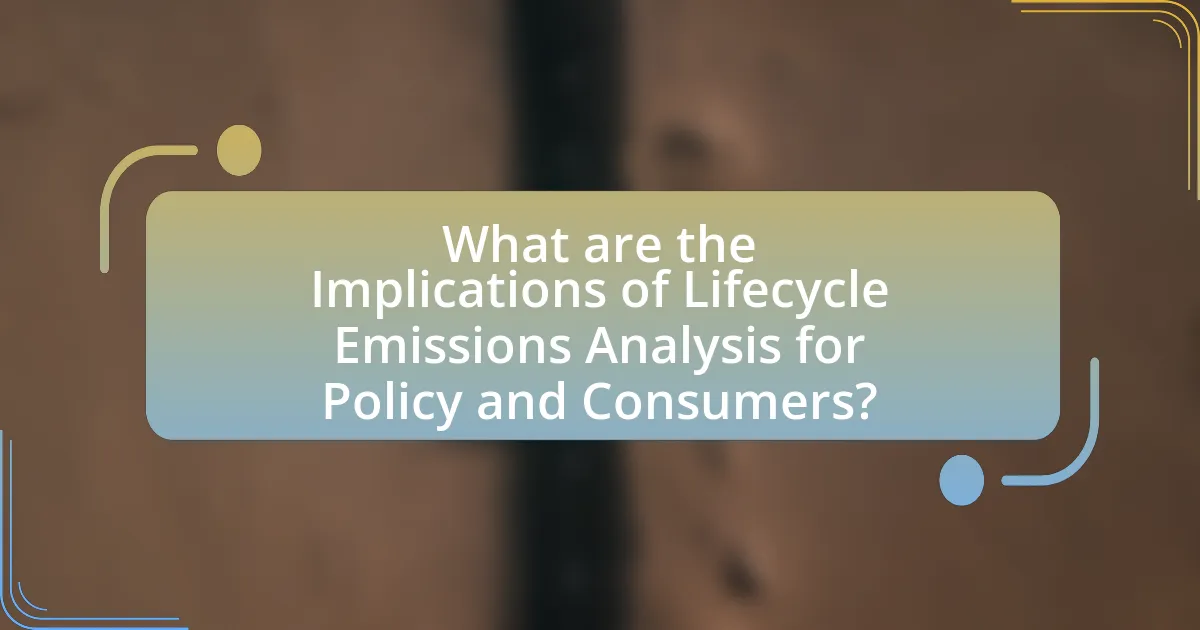
What are the Implications of Lifecycle Emissions Analysis for Policy and Consumers?
Lifecycle emissions analysis has significant implications for both policy and consumers by providing a comprehensive understanding of the environmental impact of products throughout their entire lifecycle. For policymakers, this analysis informs regulations and incentives aimed at reducing greenhouse gas emissions, as it highlights the total emissions associated with production, use, and disposal of vehicles. For instance, studies indicate that electric vehicles (EVs) can have lower lifecycle emissions compared to conventional vehicles, especially when powered by renewable energy sources. This data can lead to policies that promote EV adoption, such as tax credits or infrastructure investments.
For consumers, lifecycle emissions analysis empowers informed decision-making by revealing the true environmental costs of their vehicle choices. Consumers can compare the long-term emissions of electric versus conventional vehicles, leading to more sustainable purchasing decisions. Research shows that while the upfront cost of EVs may be higher, their lower operational emissions and potential savings on fuel can make them more environmentally and economically viable in the long run. Thus, lifecycle emissions analysis serves as a critical tool for shaping effective policies and guiding consumer behavior towards more sustainable practices.
How can policymakers use lifecycle emissions data to promote sustainable transportation?
Policymakers can use lifecycle emissions data to promote sustainable transportation by implementing regulations and incentives that favor low-emission vehicles. This data provides a comprehensive view of the environmental impact of vehicles from production to disposal, allowing policymakers to identify the most sustainable options. For instance, studies show that electric vehicles (EVs) typically have lower lifecycle emissions compared to conventional gasoline vehicles, especially when powered by renewable energy sources. By leveraging this data, policymakers can design tax incentives for EV purchases, invest in charging infrastructure, and establish stricter emissions standards for conventional vehicles, thereby encouraging a shift towards more sustainable transportation options.
What regulations could be implemented to reduce vehicle emissions?
Regulations that could be implemented to reduce vehicle emissions include stricter fuel economy standards, emissions testing requirements, and incentives for electric vehicle adoption. Stricter fuel economy standards, such as those set by the Corporate Average Fuel Economy (CAFE) regulations in the United States, compel manufacturers to produce vehicles that consume less fuel and emit fewer pollutants. Emissions testing requirements ensure that vehicles meet specific emissions thresholds throughout their operational life, thereby reducing harmful emissions. Additionally, providing incentives for electric vehicle adoption, such as tax credits or rebates, encourages consumers to choose cleaner alternatives, which can significantly lower overall vehicle emissions. According to the International Council on Clean Transportation, implementing such regulations can lead to a substantial reduction in greenhouse gas emissions from the transportation sector.
How can incentives for electric vehicles impact lifecycle emissions?
Incentives for electric vehicles (EVs) can significantly reduce lifecycle emissions by promoting the adoption of cleaner technologies. By providing financial benefits such as tax credits, rebates, and grants, governments encourage consumers to choose EVs over conventional vehicles, which typically have higher emissions throughout their lifecycle, including manufacturing, operation, and disposal phases.
For instance, a study by the Union of Concerned Scientists found that EVs produce, on average, 50% fewer emissions over their lifetime compared to gasoline-powered vehicles, even when accounting for emissions from electricity generation. This reduction is amplified when incentives lead to increased EV adoption, resulting in a larger share of renewable energy in the grid and further decreasing overall emissions. Thus, effective incentives not only accelerate the transition to EVs but also contribute to substantial reductions in lifecycle emissions.
What should consumers consider when choosing between electric and conventional vehicles?
Consumers should consider the lifecycle emissions associated with electric and conventional vehicles when making their choice. Electric vehicles typically produce lower emissions during operation, as they do not rely on fossil fuels, while conventional vehicles emit greenhouse gases and pollutants from gasoline or diesel combustion. A study by the Union of Concerned Scientists indicates that, over their lifetime, electric vehicles can produce less than half the emissions of comparable gasoline-powered cars, even when accounting for emissions from electricity generation. Additionally, consumers should evaluate the source of electricity used to charge electric vehicles, as renewable energy sources can further reduce overall emissions.
How can consumers assess the total emissions impact of their vehicle choice?
Consumers can assess the total emissions impact of their vehicle choice by analyzing the vehicle’s lifecycle emissions, which include production, operation, and disposal phases. This assessment can be facilitated by utilizing tools such as the Greenhouse Gas Protocol, which provides standardized methods for calculating emissions, or by referring to emissions data from reputable sources like the Environmental Protection Agency (EPA) and the International Energy Agency (IEA). For instance, the EPA’s Fuel Economy Guide offers detailed emissions information for various vehicle models, allowing consumers to compare the carbon footprint of electric vehicles versus conventional gasoline vehicles.
What resources are available for consumers to make informed decisions?
Consumers can access various resources to make informed decisions about electric and conventional vehicles, including government websites, independent research studies, and consumer advocacy organizations. Government websites, such as the U.S. Department of Energy, provide data on vehicle emissions, efficiency ratings, and incentives for electric vehicles. Independent research studies, like those published by the International Council on Clean Transportation, offer detailed analyses of lifecycle emissions for both vehicle types. Additionally, consumer advocacy organizations, such as Consumer Reports, evaluate vehicle performance, safety, and environmental impact, helping consumers compare options effectively. These resources collectively empower consumers with factual information necessary for making educated choices regarding their vehicle purchases.
